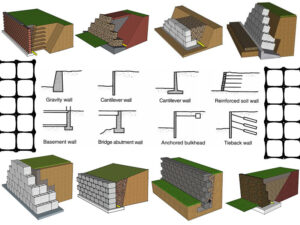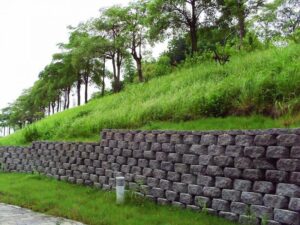Geomembrane Used For Impermeable, Waterproofing, Drainage
Pond liners are crucial for maintaining the long-term stability of water bodies used for water storage, aquaculture, farm ponds, or garden pond landscaping. To prevent water from seeping into the ground and ensure stability, you need geomembrane pond liners or bentonite pond liners. These are essential for effectively controlling water loss in pond or pool projects.
Geomembranes used for pond liners are typically HDPE and LLDPE. They are flexible, durable, impermeable barriers with strong UV and chemical resistance, widely used in various ponds, reservoirs, and water bodies. high density polyethylene pond liners are ideal for projects requiring long-term durability and precise water control.
Bentonite pond liners usually use sodium-based bentonite, which is sealing and environmentally friendly, making it very suitable for natural ponds or water bodies.
Both types of liners play a vital role in preventing water loss and maintaining pond stability. Therefore, you need to select the appropriate pond liner based on project requirements.
Overview of Polyethylene Geomembrane Pond Liners and Sodium Bentonite Clay Pond Liner
Polyethylene pond liners and sodium bentonite pond liners are key materials used in hydraulic engineering. They provide reliable waterproofing protection. Polyethylene pond liners include two types: HDPE and LLDPE. Each type has unique characteristics suitable for different applications.
HDPE Geomembrane
LLDPE Geomembrane
Bentonite Clay Pond Liner
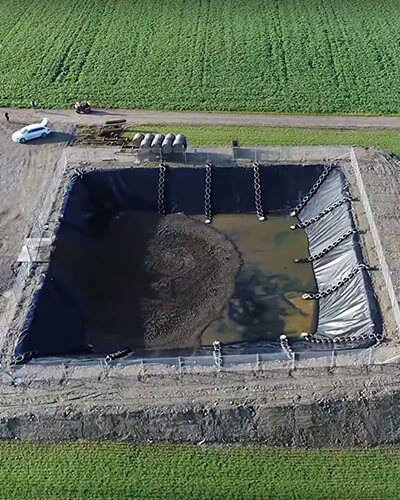
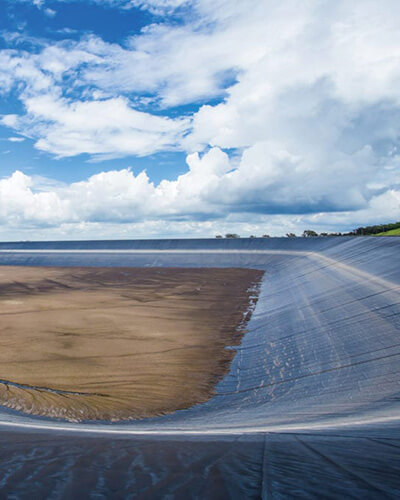
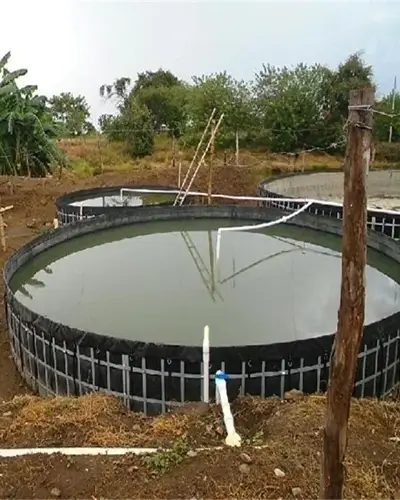
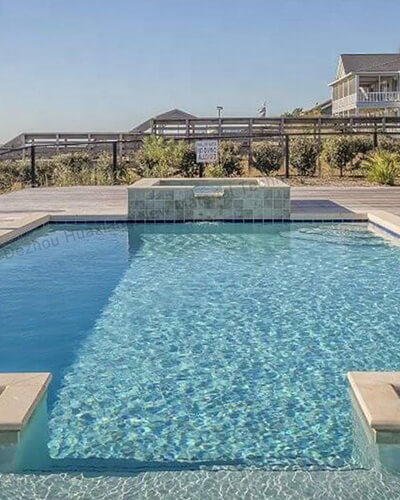
Geomembrane Pond Liners for Ponds
Geomembrane pond liners are among the best materials for sealing water in ponds. Their impermeability prevents water loss due to leakage, ensuring the stability and functionality of the water body.
HDPE pond liners are known for their high chemical resistance, UV stability, and long lifespan, making them suitable for large ponds or reservoirs requiring durable solutions.
LLDPE pond liners are more flexible, allowing them to better adapt to irregular surfaces or ponds with complex shapes.
Polyethylene geomembrane pond liners also serve as barriers against pollution, protecting surrounding soil and groundwater from potential contaminants or chemicals in the pond water.
Common applications for hdpe geomembrane pond liner sheet and LLDPE pond liners include garden ponds, farm pond, recreational pools, ornamental ponds, fish ponds, and agricultural reservoirs.
During installation, they can be customized to fit the specific dimensions of the pond or reservoir. Their flexibility ensures a good fit to the terrain, reducing the risk of installation-related issues. Typically, high density pond liners need to be paired with geotextiles fabric in pond construction. A layer of geotextile fabric should be laid down before the HDPE sheet, protecting the pond liner from sharp objects like rocks and tree roots while preventing air gaps between the pond liner and the ground.
Sodium Bentonite Pond Liners for Ponds/Pools
Sodium bentonite clay pond liners are an effective and natural water retention solution for ponds and reservoirs. Known for their ability to expand multiple times when wet, sodium bentonite forms a dense, impermeable layer that prevents water from seeping into the ground.
The principle behind this is that when bentonite clay comes into contact with water, it expands to fill any voids or gaps in the soil, creating a tight seal that retains water within the pond or reservoir.
One of the unique features of bentonite is its self-sealing capability. If minor damage or punctures occur, the clay naturally expands to fill the gaps, maintaining the integrity of the pond and preventing leaks.
Bentonite is a natural, environmentally friendly material, making it an ideal choice for ponds and reservoirs concerned about environmental impact. It is non-toxic, safe for aquatic life, and does not release harmful chemicals into the water.
Once installed, GCL pond liners provide long-lasting protection against water loss. As a natural material, it integrates well with surrounding soil, offering a durable and sustainable water retention solution.
Sodium bentonite clay pond liners are commonly used in irregularly shaped ponds or reservoirs, such as agricultural ponds, wildlife ponds, rainwater harvesting basins, and natural swimming pools. In these settings, natural materials are preferred over synthetic ones, and the superior expansion ability of sodium clay allows it to better adapt to the underlying surface. This flexibility is particularly beneficial for projects with uneven or complex terrain.
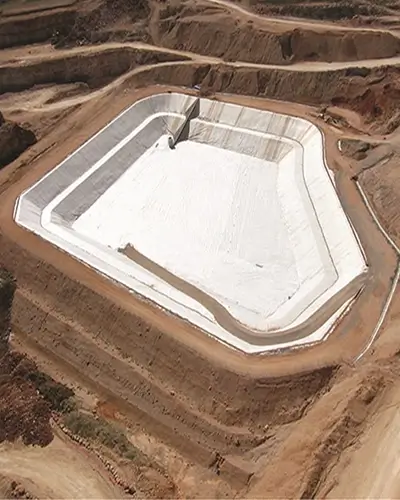
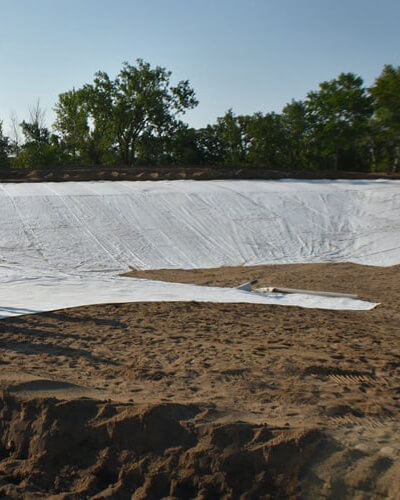
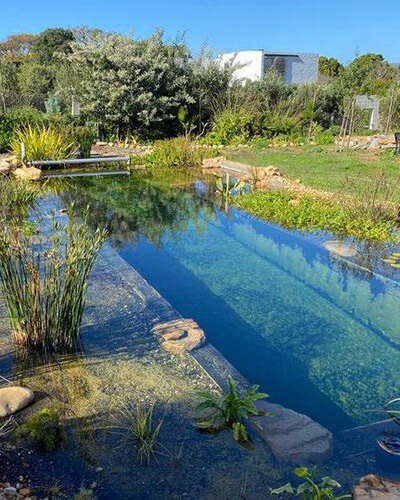
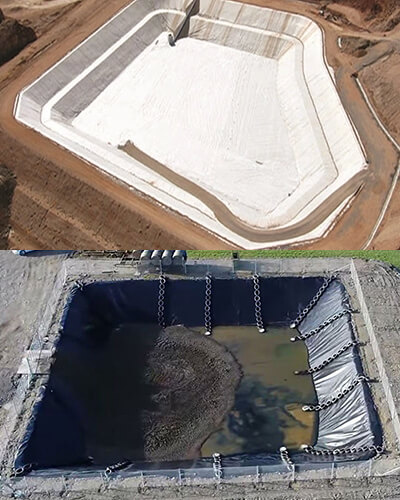
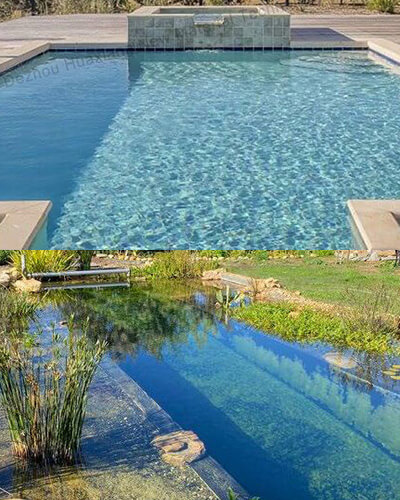
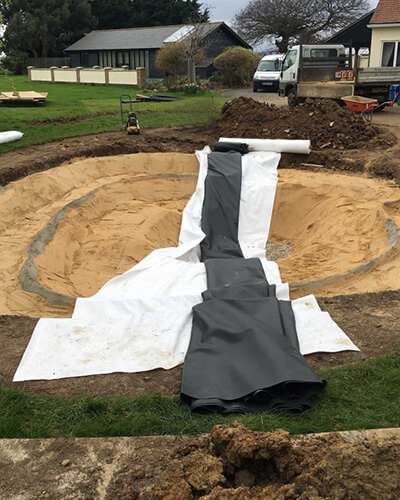
Choose Geomembrane Pond Liner or Bentonite Pond Liner for Ponds and Pools
Both HDPE Geomembrane Pond Liner and Sodium Bentonite Pond Liner have their own unique advantages in pond and pool construction. Which material to choose depends on several key factors such as the size and shape of the pond, environmental considerations and long-term performance expectations.
1. Water seepage prevention
Geomembrane pond liner: provides a completely impermeable barrier that virtually eliminates water seepage. It is particularly suitable for projects that require high-precision water retention and cannot allow water loss.
Bentonite pond liner: Compared with geomembranes, bentonite liners provide a natural but less absolute seal. Although very effective, they allow a certain degree of water absorption and are best used in environments where slight leakage can be tolerated.
2. Project size and shape
HDPE Pond Liners: Best suited for large and irregularly shaped ponds, as geomembranes can be custom cut and welded to any size or contour. They are flexible and can easily adapt to complex designs or terrains.
Bentonite Clay Pond Liners: Better suited for smaller or medium-sized ponds and ponds with simple shapes. It requires a thick application layer and careful installation, which makes it more difficult to use for large projects with complex geometries.
3. Installation
Polyethylene Pond Liner: Geomembranes are easy to install, especially prefabricated geomembranes. They come in large sheets, which reduces the number of seams and thus potential leak points. The installation time is relatively fast but may require specialized skills and equipment. Such as geomembrane welding machines, etc.
Sodium Bentonite Clay Pond Liner: The installation of bentonite liners is labor-intensive and even requires mechanical assistance. It is more sensitive to installation conditions, such as weather, dryness flatness of the base, etc. And requires more expertise.
4. Durability and Maintenance
High-Density Polyethylene Pond Liners: HDPE Geomembranes are known for their long lifespan (50+ years) and have excellent resistance to UV rays, chemicals, and environmental stresses. They require little maintenance after installation.
GCL Pond Liners: While bentonite liners can last a long time, their effectiveness can decrease over time due to drying out or erosion. They are more susceptible to environmental changes and require occasional maintenance to maintain effectiveness.
5. Environmental impact
High-Density pond liner: Although HDPE sheet is a synthetic material, it is non-toxic and safe and will not cause any adverse impact on the environment. However, the geomembrane is generally black, which looks poor visually, especially for projects such as garden ponds.
Bentonite clay pond liner: Bentonite is a natural and environmentally friendly material, and is usually the first choice for projects that focus on sustainability. It can be well integrated into the natural landscape without introducing artificial substances.
6. Cost
HDPE Liners: Typically more expensive in terms of initial material costs and professional installation, but can offer long-term cost savings due to their durability and minimal maintenance requirements.
Sodium Bentonite Pond Liners: Initially cheaper, but can cost more over time due to higher maintenance requirements and potential repairs.
Recommendations
If your project requires high precision, minimal water loss, and long-term durability, especially for large or complex ponds, choose geomembrane pond liners.
If you prefer natural, environmentally friendly solutions and are working on smaller projects, or can accept a certain degree of seepage, choose bentonite clay liners.
The combination of the two materials is the most perfect state. First lay a layer of bentonite clay liner on the bottom of the pond to protect the geomembrane from being pierced by sharp objects such as rocks and tree roots, and prevent the formation of air gaps between the pond liner and the ground, as a second barrier to prevent leakage. Then lay the geomembrane pond liner on it, mainly to prevent leakage. This can be 100% safe and worry-free.
Recent Projects
Discover our recent client projects and explore the range of tailored, personalized support we provide. Share your requirements and receive the ideal solution.
Recent Company News
Explore our newest releases, stay informed with industry updates on geosynthetics & geocomposite, and delve into technical insights about geotechnical products. For any queries, reach out to us for customized assistance.
Frequently Asked Questions
The main differences in the cost of geomembranes and bentonite pond liners are as follows:
The thickness of geomembranes for shallow ponds (depth 0.8m-1.5m) is 0.5mm-0.75mm (500 micron – 750 micron), and the price is $0.25-$0.75 / Square Meter.
The thickness of geomembranes for deep ponds (depth 2m-3m) is 0.75mm-1.5mm (750 micron – 1500 micron), and the price is $0.3-$0.88 / Square Meter.
The price of bentonite pond liners is between $1.5-3.82 / Square Meter.
The installation and maintenance costs of geomembranes and bentonite pond liners depend on the size of the pond, the amount of materials used, and other factors. It is impossible to give a specific estimate, and it needs to be calculated based on the actual situation.
If you want to know the Geomembrane and Bentonite Pond Liner specific cost price, please contact QIVOC with detailed project data. As a leading GCL and HDPE Pond Liner manufacturer in China, we will provide you the most suitable quotation.
The thickness of the commonly used HDPE pond liner is 500 micron, 300 micron, 1mm.
The sodium bentonite pond liner is usually 500gsm.
Regarding their cost prices, please feel free to contact us for the latest quotation.
Which liner is more suitable for my pond’s size, shape, and soil conditions?
If your project requires high precision, minimal water loss and long-term durability, especially for large or complex ponds, choose geomembrane pond liners.
If you prefer natural, environmentally friendly solutions and are dealing with smaller projects, or can accept a certain degree of water seepage, choose bentonite clay liners.
Of course, you can contact us for the best solution recommendation.
Both materials are safe and pollution-free products. Therefore, they will not cause any adverse effects on the ecological environment around the pond. If your project is in an environmentally sensitive area, it is recommended that you choose natural bentonite pond liner.
Installation requirements and time frame for geomembrane pond liners
The installation requirements for geomembrane pond liners include base cleaning, laying points, welding requirements, and peripheral joint treatment.
Base cleaning: Before laying the geomembrane, the bottom and side walls of the pond must be cleaned to remove sharp stones, tree roots, and other debris.
Laying points: The geomembrane should be spread flat on the bottom of the pond, the height of the side wall should be consistent with the height of the membrane, and the side wall should be wrapped inside the membrane. The membrane edges overlap by 10-15 cm and are processed by hot melt welding to ensure that the welds are firm and flat without leakage.
Welding requirements: For larger pools, multiple geomembranes may need to be welded. When welding, the splicing must be neat, the welds must be firm and flat, and there must be no leakage. At the same time, other parts of the geomembrane should be checked for scratches that may occur due to transportation, handling, etc., and cracks should be repaired in time.
Treatment of peripheral joints: Since the geomembrane is only laid on the bottom of the pond and does not cover the surrounding walls, the treatment of the joints between the bottom of the wall and the geomembrane is particularly important. Dig a foundation trench of appropriate depth and width at the base of the wall, press the edges of the geomembrane into the foundation trench, and then pour reinforced concrete to level it, so as to effectively prevent leakage from the wall foundation.
In addition, when laying geomembranes, it is necessary to choose sunny weather to avoid construction on rainy days or humid environments to ensure that the geomembrane can fully play its anti-seepage role.
Installation requirements and time range of sodium bentonite pond liner
The installation requirements of bentonite pond liner mainly include base treatment, preparation before laying, laying method, and treatment of joints and anchors.
Base treatment:
1. The base should be divided into soft base and hard base. It needs to be leveled and compacted before laying. The compaction degree should be more than 85%. The surface should be flat and smooth, without rocks and other objects protruding more than 2cm, and there should be no obvious voids.
2. There should be no toxic and harmful substances in the upper layer of the artificial lake foundation, and the surface should be dry without water accumulation.
3. The radius of the base layer and the rounding of the positive corner should not be less than 30cm. If necessary, take measures to fix it to ensure compaction.
4. The through pipes must be fixed and reinforced with concrete to prevent shaking.
5. The anchor trench must be dug and compacted as required.
Preparation before laying:
1. Carry out material analysis, draw the laying sequence and cutting diagram of bentonite composite waterproof mat (GCL).
2. Check the appearance quality of GCL, record and repair the mechanical damage, production trauma, voids and other defects found.
3. Construction should be carried out in rainless and snowless weather, and avoid driving any equipment on the laid geosynthetics to prevent damage.
Laying method:
1. The weight of bentonite waterproof blanket material is large, so it is advisable to use a shovel with waterproof blanket lifting tools for transportation and laying.
2. The connection adopts the overlapping method. When laying on a slope greater than 10%, the number of overlaps along the length of the slope should be minimized. The bentonite mat on the slope must exceed the toe line of the slope by more than 1500mm.
3. All exposed bentonite waterproof blanket edges must be immediately compacted with sandbags or other heavy objects to prevent them from being blown by the wind or pulled out of the surrounding anchor trench.
4. The laying method must ensure that the bentonite waterproof blanket is in direct contact with the foundation below, excluding wrinkles, folds or arches.
Joint and anchoring treatment:
1. The overlap width should not be less than 200mm. Sprinkle bentonite sealing powder on the edge of the overlapping bottom bentonite waterproof blanket, with a width of 50mm and a weight of 0.5kg/m.
2. In windy weather, bentonite sealing paste should be used for sealing.
3. The connection between the bentonite waterproof blanket and the pipeline and structure should be carefully sealed using the “strip method” or “paste method”. When laying on the facade and slope, anchor nails and gaskets can be used to fix it to avoid sliding.



